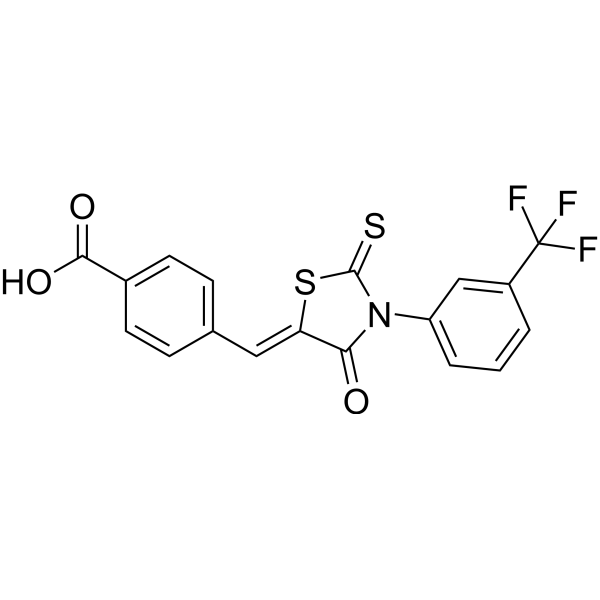Home
Products
CFTRinh-172



| Product Name | CFTRinh-172 |
| Price: | Inquiry |
| Catalog No.: | CN00245 |
| CAS No.: | 307510-92-5 |
| Molecular Formula: | C18H10F3NO3S2 |
| Molecular Weight: | 409.4 g/mol |
| Purity: | >=98% |
| Type of Compound: | Alkaloids |
| Physical Desc.: | Powder |
| Source: | |
| Solvent: | Chloroform, Dichloromethane, Ethyl Acetate, DMSO, Acetone, etc. |
| SMILES: | S=C1SC(=Cc2ccc(cc2)C(=O)O)C(=O)N1c1cccc(c1)C(F)(F)F |
| Contact us | |
|---|---|
| First Name: | |
| Last Name: | |
| E-mail: | |
| Question: | |
| Description | CFTR(inh)-172 is a potent and selective blocker of the CFTR chloride channel; reversibly inhibited CFTR short-circuit current in less than 2 minutes with a Ki of 300 nM. |
| Target | Ki: 300 nM (CFTR)[1] |
| In Vitro | Inhibition by CFTR(inh)-172 is complete in approximately 10 minutes (t1/2=4 minutes) and is reversed after ishout with t1/2 approximately 5 minutes. CFTRinh-172 is nontoxic to FRT cells after 24 hours at concentrations up to 100 μM[1]. CFTR(inh)-172 does not alter CFTR unitary conductance (8 pS), but reduces open probability by > 90% with Ki=0.6 μM. This effect is due to increased mean channel closed time without changing mean channel open time. The Ki values for inhibition of Cl- current in wild-type, G551D, and G1349D CFTR are about 0.5 μM; however, Ki is significantly reduced to 0.2 μM for vF508 CFTR[2]. |
| In Vivo | A single intraperitoneal injection of CFTR(inh)-172 (250 μg/kg) in mice reduces by more than 90% cholera toxin–induced fluid secretion in the small intestine over 6 hours. CFTR(inh)-172 is nontoxic at high concentrations in mouse models. CFTRinh-172 significantly reduces fluid secretion to that in saline control loops, whereas an inactive CFTRinh-172 analog does not inhibit fluid secretion[1]. |
| Cell Assay | CFTR(inh)-172 is diluted in DMSO as a 10 mM stock solution and diluted with appropriate medium. Fischer rat thyroid (FRT) cells coexpressing human wild-type CFTR and the halide indicator YFP-H148Q are generated. Cell toxicity is assayed by the dihydrorhodamine method at 24 hours after cell incubation with 0–1,000 μM inhibitor CFTR(inh)-172[1]. |
| Animal Admin | Mice: Animal toxicity is assessed by measurement of serum chemistries and hematology in mice at 5 days after daily intraperitoneal injections with 0-1,000 μg/kg CFTR(inh)-172[1]. |
| Density | 1.6±0.1 g/cm3 |
| Boiling Point | 555.7±60.0 °C at 760 mmHg |
| Flash Point | 289.9±32.9 °C |
| Exact Mass | 409.005432 |
| PSA | 115.00000 |
| LogP | 4.51 |
| Vapour Pressure | 0.0±1.6 mmHg at 25°C |
| Storage condition | Store at +4°C |